the PartnerShip Connection blog
the PartnerShip Connection blog
the PartnerShip Connection blog
the PartnerShip Connection blog
the PartnerShip Connection blog
-
Freight Class Made Easy: Top Resources for Every Shipper
09/07/2023 — Jen Deming
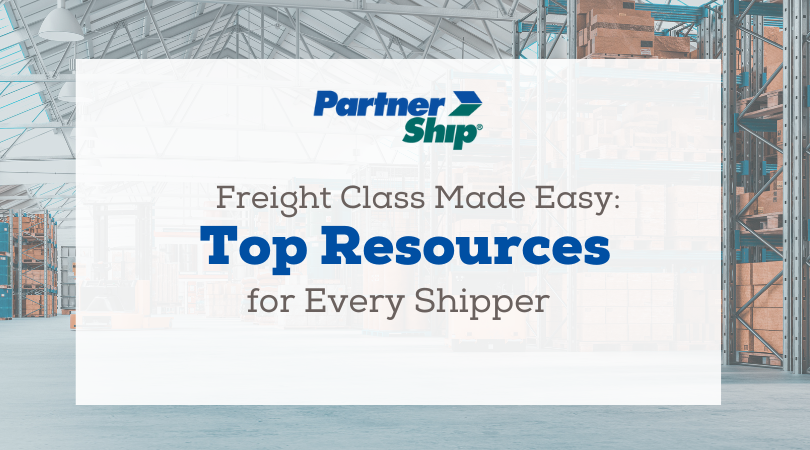
When it comes to shipping goods via less-than-truckload (LTL), understanding freight class is essential. Freight class is a numeric code that categorizes different types of products or commodities for shipping purposes. It plays a crucial role in determining the cost of your shipment and other factors such as weight, distance, and additional services. In this comprehensive list of resources, we will delve into the intricacies of freight class, covering everything from the very basics to tools that can help you determine class.
Resources that will help you understand everything you need to know about freight class:
- Understanding the basics of a freight class.
Freight classification is a crucial component of LTL shipping, but the system can be complicated. Factors such as density, storage/stowability, and liability all impact class, and the higher the number usually means the higher the rate. This article will help you understand the basics of freight class, and includes information about a valuable tool, ClassIT, that can help shippers accurately determine their product classification. - Grasp the impact of density in freight shipping.
Packaging, commodity type, and specs all impact the cost of your freight, but some products have an added layer of mystery (and math) when it comes to class - density. Density is calculated by measuring the height, width, and depth of the shipment, including skids and packaging. Learn more from our insights about why carriers are putting such an emphasis on shipment density and how it affects your freight costs. - Decipher the complicated nature of an FAK.
An FAK is a class agreement between a carrier and a shipper, allowing the shipper to move multiple products of different classes at one standardized freight class. Sounds simple, right? The catch is that carriers have held back in entering these agreements more now than they used to. This article takes a closer look at what defines an FAK, what shippers are likely to qualify, and if it’s something that makes sense for your business. - Master the factors that affect your freight class.
Freight classification is an essential process in LTL shipping that involves categorizing products based on specific criteria like density, stowability, liability, and handling. Understanding these variables is crucial for calculating the class and cost of shipping. This infographic can help you more easily understand the factors that determine class and how to get it right.
Tools that will help you determine your freight class:Shippers should have access to the tools they need, when they need it. That’s why we've made two resources available online that can help sort through some of the toughest parts of freight shipping - calculating density and freight classification.- Let the freight experts determine class for you.
Finding a freight class can be complicated but working with the team at PartnerShip can help take out the guesswork. By providing details on our online form such as the dimensions, weight, density, and product type, our team can help sort through the jargon and provide you with an accurate class for your shipment.
- Calculate density accurately with this free tool.
A density calculator is a tool that helps shippers determine the density of their shipments. It measures how heavy a shipment is relative to its size. By inputting the weight and dimensions of the shipment into our calculator, you can easily determine the density and check your estimated freight class.
Get a handle on freight class with the right resources and tools
Freight class is a critical component of shipping your LTL loads, but it's confusing and making a guesstimate is risky business. Your shipment's freight class plays a huge part in everything from your initial rate estimate to your payout for any potential damage claims. How can a little number mean so much? The team of experts at PartnerShip can help put an end to your freight class frustration. Say goodbye to head-scratching and hello to efficient solutions. Contact us to learn more.
Click to read more... - Understanding the basics of a freight class.
-
4 Key Factors That Affect Your Freight Class
08/24/2021 — Jen Deming
Freight classification is a type of product categorization unique to freight shipping. It relies on four factors that help determine cost: density, stowability, liability, and handling. Once you have a general understanding of these variables, you can better calculate how your class (and cost) will be determined.

Click to read more... -
Freight Class Explained: FAK FAQs
02/27/2019 — Jen Deming
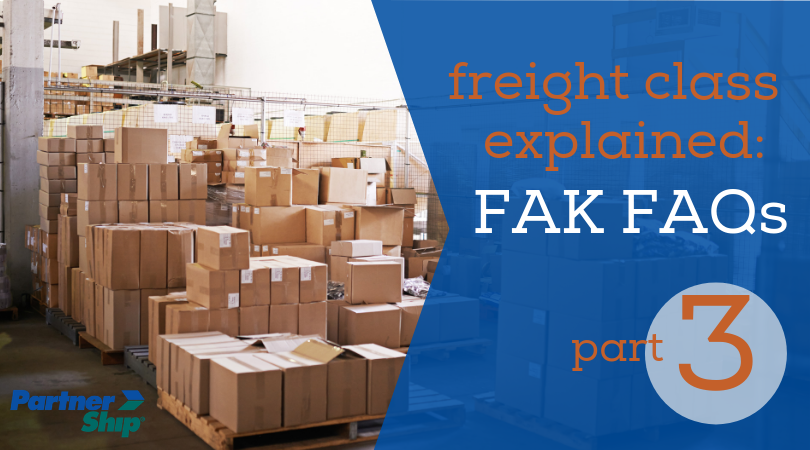
There seems to be an endless number of factors that can affect freight class, and in our last two blog posts, we covered the most significant, including product category, materials, packaging, and density. When we talk freight class with our customers, many shippers ask about a potential or existing FAK (Freight All Kinds) rating, and whether it's getting them the best pricing possible. yes, we're throwing another shipping acronym in the mix. We'll take a look at what it is, which shippers quality, and whether or not it really is right for your business.
What is an FAK?
An FAK is a class agreement that is established between a carrier and a shipper, allowing the shipper to move multiple products of different classes at one standardized freight class. Essentially, an average class of all the commodities being shipped is determined, and the shipment gets rated at the same class regardless of the product type, making the price fair for both the carrier and the shipper.
How does this differ from a class exception?
A class exception agreement utilizes an umbrella system that may rate a range of actual class items at a lower class. For example, a business that may ship items classed at 70-200 may be rated at a class 150. Anything above class 200 would ship actual class. A true FAK is extremely rare for a shipper to negotiate with a carrier, as it requires extremely high volume for carriers to determine it worth their while.
How does a carrier determine whether an FAK is possible?
As mentioned above, freight carriers really have a lot of the control and are calling the shots in many parts of the freight industry. A shipper must really be moving a high volume of loads in relatively even amounts in order for lower-classed items to offset higher-classed items, making the compromise worthwhile to the carrier. Originally, when FAK classification agreements were first implemented, they were beneficial to both parties. However, many shippers learned how to manipulate the agreement, shipping risky freight loads at a lower cost, and putting carriers in the hot seat. To combat the misuse of the system, carriers have held back in entering these agreements more now than they used to.
If you are a rockstar at optimizing the packaging and maneuverability of your high-class freight, taking into consideration density, fragility, and stowability, you have a better shot at obtaining an FAK. Basically, if you can get your freight to operate like a lower class, you may be rewarded with a lower class.
What's the catch?
If anything proves true in freight shipping, it's that nothing is as simple as it seems. An FAK can seem like an awesome idea with a few drawbacks, but even if a shipper does manage to acquire an FAK with a carrier, it doesn't mean it's exclusively beneficial. Keep in mind that carriers are in charge and the parameters in place are pretty much at their discretion. If you are not shipping lots of mixed pallet freight, it just doesn't make sense. Small to medium-sized businesses that have one or two major commodity types won't see the same benefits of an FAK as facilities that are mass producing many types of products would.
If you are typically shipping lower-classed items, keep in mind that your "average" class could potentially be higher than your actual class, because you are essentially increasing your minimum charge. It may save you on the one-off shipment, but it's hurting you in the long run. The same goes for a class exception strategy. Carriers are not likely to be open to lumping any of your shipments of a higher class into this tier, no matter how infrequent they are. Because of this, your tired structure will likely reflect a higher average class, which is essentially over-classing your shipments.
Another notable consequence of FAK implementation is that carriers will often limit liability on these shipments. In many carrier tariffs, verbiage is in place that the carrier is responsible for the price per pound on the freight class being paid. This is very different from actual class. If you are shipping a high value load at a very low class, even if the damage claim is won, the payout would be minimal compared to the value of the shipment.
What's my class?
Now that we've gone over how an FAK can affect freight class, let's take a look at an example shipment that would create a difference for shippers with and without an FAK. We can use a hypothetical where we are a shipper with an FAK agreement in place. If the actual freight class of our shipment falls within 70-200, we are rated at 150.
In this example we will be looking at a pallet of popped popcorn, in boxes, measuring 40 x 48 x 52 and weighing 315 lbs. This is a common shipment that would typically be rated as density-based, and would have a high class due to the fact its density is low. We will use ClassIT in order to determine the actual class and compare it versus the FAK.
With the search tool, we use the keyword "popped popcorn." It's important to note the distinction between popped popcorn and popcorn kernels because popped popcorn is much less dense, and a higher-classed shipment than raw kernels. Our shipment best falls into the Foodstuffs Group, which is a general group of foods, beverages, and other types of non-perishable items that are broken down into many articles usually determined by density:
 In this case, we will use the Snack Foods group, which is broken down into many different subgroups:
In this case, we will use the Snack Foods group, which is broken down into many different subgroups: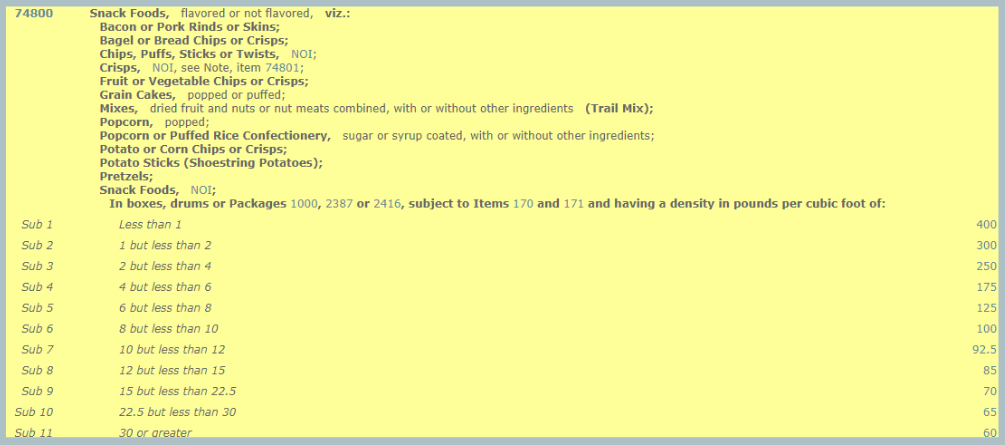 Once more, we have to figure out density. In this example, our shipment density is 5.75 lbs. per cubic foot. It fits under Sub 4, or class 175. This is a pretty high shipment class, and would result in a high freight rate. In our hypothetical example, our FAK would get this actual class 175 shipment rated at a class 150. Dropping to 150 isn't a huge difference for a final freight rate, but should anything happen to the shipment in transit, it could potentially pay out much less than what the actual class would.FAK is just another added layer to the very complicated topic of freight classes. While they may sound like a great alternative to paying actual class, it's pretty clear that with the current state of the freight shipping industry, carriers are dictating the terms for shippers. FAK agreements are rare, and it's likely they aren't the best option available to lower freight cost anyway. The most important thing for shippers to consider isn't an FAK or even a discount percentage - it's what you are paying for your freight. A qualified freight broker can help alleviate the stress of shopping rates, and make sure you are paying for freight at the class that's right for you.
Once more, we have to figure out density. In this example, our shipment density is 5.75 lbs. per cubic foot. It fits under Sub 4, or class 175. This is a pretty high shipment class, and would result in a high freight rate. In our hypothetical example, our FAK would get this actual class 175 shipment rated at a class 150. Dropping to 150 isn't a huge difference for a final freight rate, but should anything happen to the shipment in transit, it could potentially pay out much less than what the actual class would.FAK is just another added layer to the very complicated topic of freight classes. While they may sound like a great alternative to paying actual class, it's pretty clear that with the current state of the freight shipping industry, carriers are dictating the terms for shippers. FAK agreements are rare, and it's likely they aren't the best option available to lower freight cost anyway. The most important thing for shippers to consider isn't an FAK or even a discount percentage - it's what you are paying for your freight. A qualified freight broker can help alleviate the stress of shopping rates, and make sure you are paying for freight at the class that's right for you.
Click to read more... -
Freight Class Explained: Demystifying Density
02/20/2019 — Jen Deming
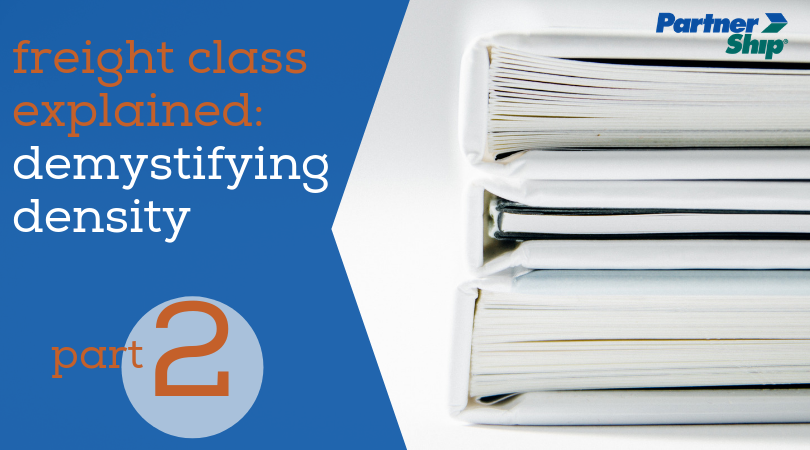 So, you've been brushing up on freight class and you're starting to get a hang of how it's determined. In the first part of our freight class series, we learned that packaging, commodity type, and dimensional features all influence the final code that ultimately affects your shipping price. Just when you thought you had a handle on the basics, we're going to throw you a little curveball. Some commodities have an added layer of mystery (and math) when it comes to their class: the density of the overall shipment. Let's sharpen some pencils and get down with density-based freight classifications.What is density?First thing's first, density is a method of measurement that relates the weight of your shipment to its dimensions, or pound per cubic foot. Typically, the higher the density, the lower the classification and vice versa. A good example of a high density shipment would be a pallet of bricks. Lower density shipments, or those that take up lots of space but are lightweight, are items such as ping-pong balls.Why are some shipments density-based and what are they?Commodities that are solid, heavy, and take up minimal space are very desirable to pretty much any freight carrier. Using density as a factor in determining freight class and pricing is becoming the new standard, especially as freight demand increases and capacity decreases. Thanks to variables such as a shortage of drivers and strict trucking legislation, carriers are trying to weed out difficult or unprofitable shipments in order to make space for more standardized loads. Time and effort are money in this industry, and carriers are taking control of who they want to ship for.How do you calculate the density of a shipment?Density is calculated by measuring the height, width, and the depth of the shipment, including skids and packaging. This is multiplied to determine cubic inches. If you have multiple pieces, multiply for each piece and add them together. Then, divide the total cubic inches by 1,728, or the total cubic inches in a foot. The result is the total cubic feet of the shipment's pieces. Divide the weight (in lbs.) of the shipment by the total cubic feet. The result is pounds per cubic foot, or density.What is my freight class?To help you better understand density-based shipments, we will look at a shipment of steel machinery parts, in a crate measuring 42 x 46 x 42 inches and weighing 500 lbs. By using the search function in ClassIT for "machinery parts", we can see a broad grouping for 114000, or the Machinery Group:
So, you've been brushing up on freight class and you're starting to get a hang of how it's determined. In the first part of our freight class series, we learned that packaging, commodity type, and dimensional features all influence the final code that ultimately affects your shipping price. Just when you thought you had a handle on the basics, we're going to throw you a little curveball. Some commodities have an added layer of mystery (and math) when it comes to their class: the density of the overall shipment. Let's sharpen some pencils and get down with density-based freight classifications.What is density?First thing's first, density is a method of measurement that relates the weight of your shipment to its dimensions, or pound per cubic foot. Typically, the higher the density, the lower the classification and vice versa. A good example of a high density shipment would be a pallet of bricks. Lower density shipments, or those that take up lots of space but are lightweight, are items such as ping-pong balls.Why are some shipments density-based and what are they?Commodities that are solid, heavy, and take up minimal space are very desirable to pretty much any freight carrier. Using density as a factor in determining freight class and pricing is becoming the new standard, especially as freight demand increases and capacity decreases. Thanks to variables such as a shortage of drivers and strict trucking legislation, carriers are trying to weed out difficult or unprofitable shipments in order to make space for more standardized loads. Time and effort are money in this industry, and carriers are taking control of who they want to ship for.How do you calculate the density of a shipment?Density is calculated by measuring the height, width, and the depth of the shipment, including skids and packaging. This is multiplied to determine cubic inches. If you have multiple pieces, multiply for each piece and add them together. Then, divide the total cubic inches by 1,728, or the total cubic inches in a foot. The result is the total cubic feet of the shipment's pieces. Divide the weight (in lbs.) of the shipment by the total cubic feet. The result is pounds per cubic foot, or density.What is my freight class?To help you better understand density-based shipments, we will look at a shipment of steel machinery parts, in a crate measuring 42 x 46 x 42 inches and weighing 500 lbs. By using the search function in ClassIT for "machinery parts", we can see a broad grouping for 114000, or the Machinery Group: Through this group, we are directed through sub-articles, where we can find the 133300 group "Machinery or Machines, NOI, or Machinery or Machine Parts, NOI". From there, we can view associated subgroups that refer to density and packaging:
Through this group, we are directed through sub-articles, where we can find the 133300 group "Machinery or Machines, NOI, or Machinery or Machine Parts, NOI". From there, we can view associated subgroups that refer to density and packaging: You may also notice the "NOI" designation for this particular breakdown. "NOI" refers to "not otherwise indicated" and was implemented by the NMFTA for commodities that do not easily fit into existing classifications. Using NOI can be risky, since most products do have a specific freight class. Since "NOI" designations tend to draw attention from carrier inspection teams, it's critical that they are used properly, and that means density must be calculated to determine the subgroup.In this example, and using the formula listed above, we can determine density using its dimensions and weight.
You may also notice the "NOI" designation for this particular breakdown. "NOI" refers to "not otherwise indicated" and was implemented by the NMFTA for commodities that do not easily fit into existing classifications. Using NOI can be risky, since most products do have a specific freight class. Since "NOI" designations tend to draw attention from carrier inspection teams, it's critical that they are used properly, and that means density must be calculated to determine the subgroup.In this example, and using the formula listed above, we can determine density using its dimensions and weight.- Multiply the length, width, and height (42 x 46 x42) to get the total cubic inches (81,444).
- Divide the total cubic inches by 1,728 to get the total cubic feet (47).
- Divide the weight of the shipment (500 lbs.) by the total cubic feet (47). This will give you a density of 10.65.
Looking at the chart, we see that because of our crated packaging type, the top 4 subgroups are applicable. 10.65 falls under the subgroup 3, or class 92.5. In this class example, it is important that dimensions and weight are accurately measured in order to calculate the true density (and appropriate class) for the shipment. It's also crucial to note once more that packaging makes a huge impact. See how high the classes jump if the product is palletized or in packages other than secure crates or boxes.
LTL services are in higher demand than ever before. National freight carriers are in the driver's seat, and doing what they can to limit troublesome shipments - including those with a low density and high freight class. Once you've optimized your shipments for carriers, many shippers wonder about whether a Freight All Kinds (FAK) agreement may be a worthwhile perk. Next, we'll take a look at what goes into that FAK and if it's right for your business. The freight specialists at PartnerShip can guide the way so you aren't stuck staring at your calculator, and a high freight bill. Call 800-599-2902 to speak with a representative, or get a quote today.

Click to read more... - Multiply the length, width, and height (42 x 46 x42) to get the total cubic inches (81,444).
-
Freight Class Explained: Bring on the Basics
02/13/2019 — Jen Deming

Freight class is a critical component of shipping your LTL loads. But it's confusing and making a guesstimate is risky business. Your shipment's freight class plays a huge part in from everything from your initial freight rate estimate to your payout for any potential damage claims. How can a little number mean so much?
What is a freight class?
Prior to understanding class number, shippers need to grasp the importance of the NMFC, or National Motor Freight Classification. Every type of product or commodity has a numeric code assigned to identify it within a categorical system, similar to a UPC used within a grocery store. The code also breaks down these products into over-arching groups, which then tell you how to class your product. There are 18 freight classes that range from 50 to 500. Your freight class helps the carrier determine how much to charge for your shipment, along with other factors such as weight and distance traveled, as well as any additional requested services. Typically, the higher the class, the more expensive the subsequent freight rate.
What factors determine a freight class?
There are four factors that influence the classification of different commodities; each affects the difficulty in transporting the freight and increases the freight class.
- Density - The space an item takes up as it relates to weight. The higher the density, the lower the classification. Low density shipments take up a lot of space but weigh less, making the shipment unprofitable to carriers. More classifications are becoming density-based as capacity becomes crunched and larger, less standard types of freight are entering the network to be shipped.
- Storage/Stowability - This refers to how easily freight can be stored and stacked on the truck, and how much space it takes up. Similar to density, if a shipment is large, oddly-shaped, or difficult to fit in the truck, the load becomes undesirable. .A higher freight class is assigned in order to reflect the added work to fit in the load.
- Handling - Similar to storage and stowability, the more difficult it is to load and unload a shipment affects freight class. A shipment that requires more creativity and flexibility to load and unload will increase the class.
- Liability - Carriers assign higher freight classes to "high risk" shipments in order to limit their accountability for those shipments that are more likely to be damaged in transit or have an increased risk for freight theft. If you have high value or fragile products, it will be reflected in a higher freight class to offset that risk.
To better understand the differences in freight classes, and how they are determined, looking at a few types of our most commonly shipped commodities can be insightful. As an example, we'll take a look at stone materials. While many shipments of stone are transported via truckload carrier, and don't need a classification listed on the shipping paperwork, there are still many instances where quarries, fabricators, and other stone suppliers need to move smaller loads for shorter distances.In order to help shippers determine freight class, the National Motor Freight Traffic Association has created an online reference tool, ClassIT. The resource is available to shippers with a membership, and it's the primary tool used by PartnerShip shipping specialists. The index can be searched by using a brief description of the commodity. Being too specific, or too vague, can create issues in your search results. Note you can search by including "any word" or "every word" to adjust your results. Let's say we have a shipment of slate blocks which are in 3 creates that are 4 ft. by 4 ft. and 515 lbs. each. We see two groupings that actually fall into the same Item or NMFC number, which is 90280. This is considered the "Gravel or Stone Group; consisting of gravel, sand, slag, slate, or stone, as described in items subject to this grouping." If we select "Slate Blocks, Pieces or Slabs, NOI" we are brought to the following breakdown of articles. You can see how specific it gets regarding packaging, usage, and dimensions.By looking at our shipment of crated slate blocks, we can see that our sample shipment falls under the 90280 Slate Blocks Pieces or Slabs group:
Let's say we have a shipment of slate blocks which are in 3 creates that are 4 ft. by 4 ft. and 515 lbs. each. We see two groupings that actually fall into the same Item or NMFC number, which is 90280. This is considered the "Gravel or Stone Group; consisting of gravel, sand, slag, slate, or stone, as described in items subject to this grouping." If we select "Slate Blocks, Pieces or Slabs, NOI" we are brought to the following breakdown of articles. You can see how specific it gets regarding packaging, usage, and dimensions.By looking at our shipment of crated slate blocks, we can see that our sample shipment falls under the 90280 Slate Blocks Pieces or Slabs group:
It goes even further than that, breaking down into subgroups which determine freight class depending on packaging and size. This is why it is imperative to know the precise weight and dimensions of your shipment. In our example, our slate blocks are in crates 48 in. long, which falls under the subgroup 4 - class 65. Compare that to crated slate blocks longer than 96 in., which would be class 85. This is an increase, but shouldn't affect pricing drastically. When packaging type is adjusted, however, the class is increased significantly. By palletizing the slate blocks (subgroup 1), freight class jumps to 250. At this weight, the final freight rate can be raised by hundreds of dollars.
In the Slate Blocks, Pieces or Slabs group, you can also reference three separate notes that are relevant to the details of the shipment:

These details are notable, because it gives further direction on how best to package your freight for both safety and security. In 90282, the note states that "pieces or slabs 2 in. or less in thickness" must be boxed or crated and marked "fragile." We see more packaging direction in 90283 regarding exposed surfaces and edges and requirement for wrapping and other protection. This is to hopefully limit damage, but shippers must also be mindful that if freight falls within this category, and it is not packaged as directed, a damage claim will likely be denied by the carrier.
Freight class, in addition to weight and distance traveled, is critical in determining a shipment rate. Specific details relating to product and packaging can greatly affect the NMFC code and final freight class. A shipment of slate blocks may sound simple enough, but things can get a bit more complicated once you start looking at different commodities. Density-based shipments can further befuddle shippers, and understanding these types of classifications is the next type of class breakdown we will tackle. The experts at PartnerShip can lend expertise so you can stop scratching your head. Call 800-599-2902 to speak with a representative, or find your freight class online.
Click to read more... -
How to Calculate Freight Density for Shipping
01/11/2019 — Leah Palnik
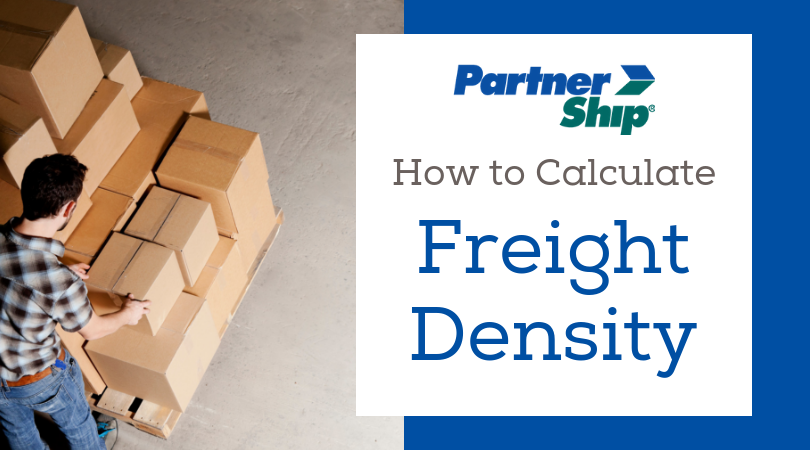
Density is a major factor in determining your freight class and your total shipment cost. In fact, many LTL carriers are relying more and more on freight density over actual weight to determine your rate. That's why it's important that you understand what freight density is and how to calculate it.
Freight density defined
Freight density measures how heavy a shipment is relative to the size of the shipment. The higher the density, the lower the classification and vice versa. A shipment with a high freight density weighs a lot relative to its size, such as densely packed books. A package with a low freight density weighs little relative to its size, such as a box filled with Styrofoam.How to calculate freight density
Step 1. Measure the height, width, and depth of the shipment in inches. Measure to the farthest points, including skids or other packaging. On shipments with multiple pieces, repeat Step 1 for each piece.Step 2. Multiply the three measurements (height x width x depth). The result is the total cubic inches of the shipment. If you have multiple pieces, multiply the height x width x depth for each piece. Take the results for each piece and add them together to get the total cubic inches
Step 3. Divide the total cubic inches by 1,728 (the number of cubic inches in a cubic foot). The result is the cubic feet of the shipment.
Step 4. Divide the weight (in pounds) of the shipment by the total cubic feet. The result is the pounds per cubic foot, i.e., density.
- For multiple pieces, add the weight of each piece together before dividing by the total cubic feet of the shipment.
- Round fractions to the nearest full cubic foot number.
Calculating freight density will also provide you with a recommended class for your shipment. The freight class chart below is an abbreviated scale you can use to help estimate the freight classification for your shipments.
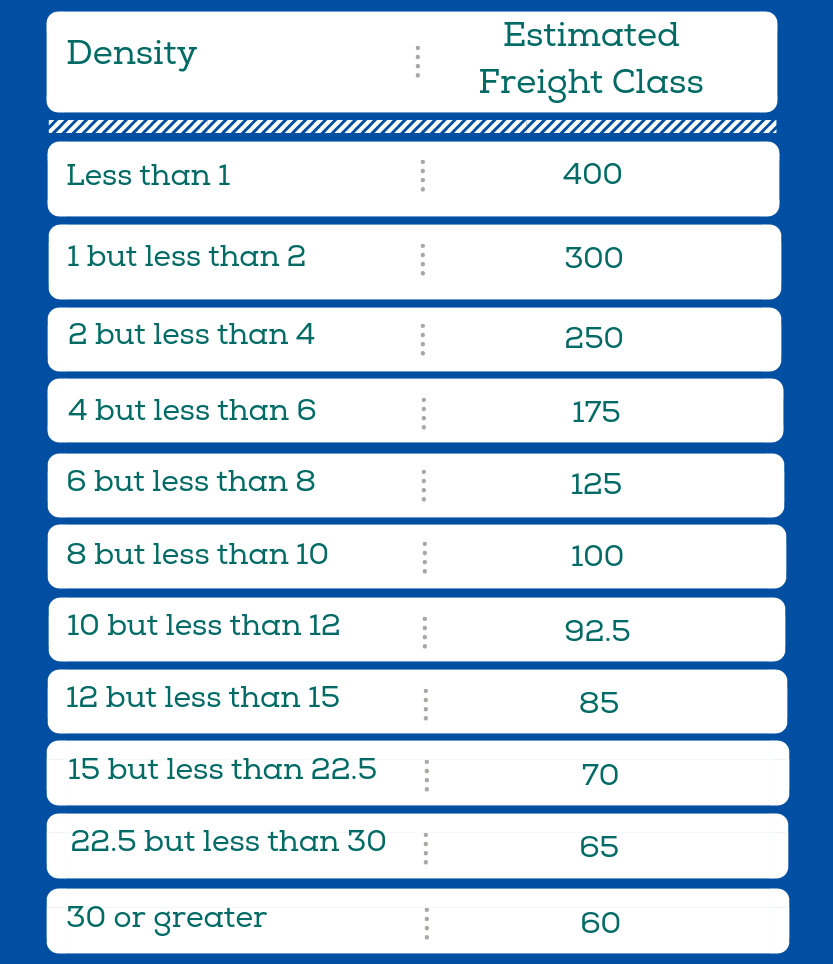
Helpful tools
There are many factors that determine your freight class, aside from density, so these are estimates only. If you're looking for help to find your freight class, our team is standing by. For a quick and easy way to figure out your shipment density, check out our freight density calculator.
Click to read more... -
What You Need to Know About Freight Class Changes
08/10/2017 — Jen Deming
Weight, density, distance, and freight classification are all important variables that help to determine your LTL freight rate. Periodically,the National Motor Freight Traffic Association (NMFTA) will update and rework these freight classes in order to keep up with industry changes when needed. One such change went into effect on August 5, 2017 and has adjusted the NMFC class breakdowns on several categories of freight shipments. What are these changes and how will they affect you as a shipper?
The most significant change is seen in the categories of LTL freight that are classed according to a shipment's density or pounds per cubic foot.Typically, the lower the density, the higher the shipment will be classed (and the higher your rate will climb). Commodities such as Plastic Articles (15660), Wire Goods (198080) and Clothing (49880) are affected by this freight class update in addition to 138 other density-based freight classes.
The good news for shippers is that the new 11-tier system will provide a lower freight class for LTL shipments that are VERY dense (over 22.5 lbs per cubic foot). If you are currently shipping loads that fall within this category, the lower freight class will potentially save you money going forward.
The other change affects mid-ranged LTL freight shipments with a class of 4-6 pounds per cubic foot previously set at class 150. With the new 11-tier breakdown, these shipments will be increasing to an updated class 175. Illustrated below, is the adjusted 11-tier classification system that will be replacing the former 9-tier model. Bold-faced density descriptions (subs) are the revised breakdowns.
It's important to mention that shippers with a FAK on certain types of commodities will also be affected. For example, if a shipper has been regularly shipping actual class 150 items at a FAK 100, and the density is 4-6 lbs per cubic foot, the shipment will now move at actual class 175 and the FAK will no longer apply.
What can shippers do to empower themselves and ensure they are doing the most they can to keep their LTL freight shipping costs low? At PartnerShip, you work directly with a dedicated freight specialist who will assist in calculating the accurate density of your shipments, and their proper freight class. Additionally, PartnerShip expertly audits your freight bills and will check for common invoicing errors, such as incorrect discounts and carrier mistakes—which cost your company money and affect your bottom line! If you are unsure on how to proceed with classifying your freight, or have a shipping challenge and don't know where to begin, PartnerShip can help point you in the right direction.
Click to read more... -
What Determines LTL Freight Rates? 9 Things You Should Know
02/16/2017 — PartnerShip
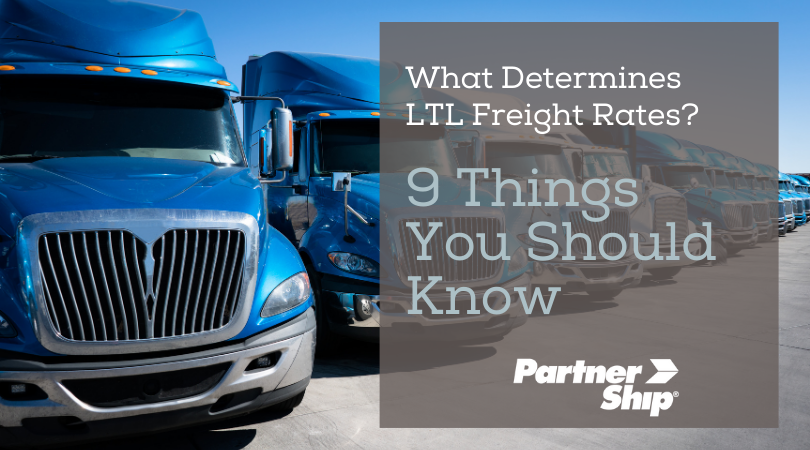 We often get questions from shippers like, “Why do freight rates fluctuate so much?” or “How are LTL rates calculated?” LTL freight rates can be a bit confusing because of their variability. While truckload freight rates are typically calculated on a per-mile rate plus a fuel charge, there are many factors that determine LTL rates, and they can significantly impact the cost of your shipment. We’ll cover nine factors that influence
LTL freight costs one by one.
We often get questions from shippers like, “Why do freight rates fluctuate so much?” or “How are LTL rates calculated?” LTL freight rates can be a bit confusing because of their variability. While truckload freight rates are typically calculated on a per-mile rate plus a fuel charge, there are many factors that determine LTL rates, and they can significantly impact the cost of your shipment. We’ll cover nine factors that influence
LTL freight costs one by one.
Weight. The more your LTL shipment weighs, the less you pay per hundred pounds, also known as hundredweight pricing. Freight carriers will refer to a chart that lists cost per hundredweight (abbreviated as CWT, or centum weight) that contains weight breaks. As your LTL shipment weight increases, it moves into the minimum weight of the next highest weight category, which has a lower rate per CWT.
Density. Density is the space a shipment occupies in relation to its weight and is determined by dividing the weight of the item (in pounds) by the volume (in cubic feet.) Freight density is a major factor in determining your shipment’s freight class. There are 18 freight classes, numbered from 50 to 500. The higher density your product is, the lower its classification (50-85). Less dense products usually have higher classifications (125-500).
Freight Class. Generally, a shipment’s density, value, stowability, handling and liability are how freight class is determined by the National Motor Freight Classification (NMFC) system. Lower classes represent very dense freight that is difficult to damage and is easy to handle. These lower classes have lower LTL shipping rates per pound. Higher classes represent lighter and less dense freight that typically takes up more space. The higher the class, the higher the freight rate.
Distance. As a rule, the longer distance your freight must travel, the higher the price per-hundred weight will be. Fuel costs, driver costs and equipment costs all increase with distance, as does your cost.
Base Rates. All LTL carriers establish their own LTL base rates which are quoted per 100 CWT. These carrier base rates are based on its volume, demand and gross costs. For example, one carrier may have a lower base rate for shipping lanes where they have a good balance between trucks and freight than another that may not.
Freight All Kinds (FAK). The Freight All Kinds classification is a pricing arrangement that allows multiple products with different classes to be shipped and billed at the same freight class. For example, a shipper that ships multiple items ranging from class 50 to 100 could negotiate an FAK to rate all items at class 70, reducing costs on higher class shipments.
Minimums. The absolute minimum charge (AMC) is the cost below which a carrier will not go. The costs a carrier experiences for a minimum charge shipment typically exceeds the costs they experience for larger, heavier shipments.
Negotiated discounts. Third party logistics (3PL) freight brokers can often save an additional 18 to 25% off LTL freight rates based on the volume of business that the 3PL brings to the freight carrier. For every $10,000 in freight costs, that’s an extra $1,800 to $2,500 in savings!
Accessorials. Freight accessorial charges are extra services performed by the carrier that go beyond dock-to-dock pick up and delivery. Common examples include lift gate service, residential pickup or delivery, limited access locations and inside delivery. A fuel surcharge is the most common accessorial and is typically included on every shipment.
LTL freight costs can be reduced by managing one (or more) of these factors. Working with a freight broker like PartnerShip will help you ship smarter and stay competitive by matching your LTL freight shipping needs with one of our many carrier partners, and in many cases, allow you to get the best LTL freight rates possible. If you're not sure where to start, or have a challenging shipping puzzle, we’d love to help! Contact us at 800-599-2902 or get a quote now!
Click to read more... -
An Introduction to Freight Classes
06/27/2016 — PartnerShip
 The first time I was introduced to the concept of a
freight class was an eye-opener. At the
time, I was responsible for getting all trade show materials to the show site, including
product samples, marketing collateral, and trade show booth. The company where
I worked had a 100,000 sf warehouse, trucks inbound and outbound all week long,
and a guy who managed the warehouse. He was the one that shipped our trade show
materials. When we outgrew our booth and needed a new one, we worked with a local trade show exhibit company and had them ship our materials to the show. When our freight invoice arrived after the show, I was floored! It was considerably more than I was used to paying. That was when I learned about freight classes. The warehouse guy always shipped our trade show exhibit Class 50, which is not the correct freight class. It should have been shipped Class 125, which the trade show company did, resulting in higher shipping charges. My lesson: freight class impacts cost.
The first time I was introduced to the concept of a
freight class was an eye-opener. At the
time, I was responsible for getting all trade show materials to the show site, including
product samples, marketing collateral, and trade show booth. The company where
I worked had a 100,000 sf warehouse, trucks inbound and outbound all week long,
and a guy who managed the warehouse. He was the one that shipped our trade show
materials. When we outgrew our booth and needed a new one, we worked with a local trade show exhibit company and had them ship our materials to the show. When our freight invoice arrived after the show, I was floored! It was considerably more than I was used to paying. That was when I learned about freight classes. The warehouse guy always shipped our trade show exhibit Class 50, which is not the correct freight class. It should have been shipped Class 125, which the trade show company did, resulting in higher shipping charges. My lesson: freight class impacts cost.
Freight class refers to the National Motor Freight Classification (NMFC) and is the category of your freight as defined by the National Motor Freight Traffic Association (NMFTA). Your shipment’s freight class determines the carrier’s shipping charges and refers to the size, value and difficulty of transporting your freight.Freight classes are designed to standardize pricing, regardless of what carriers, warehouses and brokers with which you work and is determined by weight, length and height, density, stowability, ease of handling, value and liability. There are 18 classes into which a shipment may fall; the lower the product class, the lower the rate per pound. Class 50 rates are the least expensive and Class 500 rates are the most expensive.
There is a lot of math that goes into freight class calculations (which we will not cover in depth) but here are some considerations that go into determining your shipment’s class:
- Density: The more compact a product is, based on weight, the less space it will take up in a truck. Bricks are much more dense than ping pong balls, so they take up significantly less room per pound and result in a lower freight classification.
- Stowability: Most freight stows well, but some items cannot be loaded together, like food and chemicals. Hazardous materials and oversize items also impact stowability.
- Handling: Freight is usually loaded with mechanical equipment and creates no handling issues, but weight, shape, fragility or hazardous properties do require special handling.
- Liability: Liability is determined by the probability of theft or damage, or damage to adjacent freight. Dynamite has a high amount of liability while books do not.
Here are some examples of products by freight class:
It is very important to understand freight classes and ship your materials correctly. Incorrectly classifying your freight can results in additional costs, as freight carriers have the right to inspect and reclassify your shipment. If that happens, guess who pays? You do. It can also slow delivery of your freight and will cause unneeded headaches.
The bottom line: always correctly identify and classify your freight.
Freight classes can be complex and confusing. For expert assistance on determining your shipment’s freight class, contact PartnerShip at 800-599-2902 or find your freight class online. The freight experts at PartnerShip are here to help!
Click to read more... -
Tips for Avoiding Freight Reweighs and Reclassifications
12/11/2014 — Matt Nagel
Efficiently managing your freight costs is key to keeping your bottom line in tip-top shape. One of the more common ways your freight costs increase is by the reweighing or reclassification of your freight. Carriers have the right to inspect your shipment if they deem necessary and these incidents can trip up even the most experienced shippers.
When it comes to avoiding reweighs and reclassifications, the best defense is a good offense. Doing your homework on best practices for shipping your freight and closely following these practices will give your freight the best chance of getting to it’s destination without being hit with unexpected charges.
Below we have some points of emphasis to remember before shipping your freight:
Know your freight classes: Less-than-truckload Freight Class refers to the National Motor Freight Classification (NMFC) and it is the category of your LTL freight as defined by the National Motor Freight Traffic Association (NMFTA). Your shipment's LTL freight class determines the carrier's shipping charges. It identifies the size, value and difficulty of transporting your LTL freight.
We know determining your freight class is one of the more cumbersome aspects of freight shipping, and that's why we've developed an entire ePaper on the subject, and a helpful Find Your Freight Class' tool for our customers. We ask a few simple questions about your commodity and point you in the right direction.
Stay up-to-date on industry changes: Like any industry, the freight industry is constantly changing and adapting. For example, NMFC changes evolve to accurately reflect a commodity's “transportability.” The NMFTA will post any changes on their website - regularly reviewing these types of resources will keep you in the know on the important changes that affect your freight.
Pay close attention to your shipment’s weight: Obviously very important to not being hit with a reweigh is getting it right the first time.
- All weights on the BOL should be exact weights, not approximations!
- Remember to include the weight of the pallet and other packaging in the final total weight
- Have your scales tested and calibrated often – we would recommend annually, but there’s no harm in more frequent fine tuning.
Work with an experienced partner you can trust: Even after doing your homework and following guidelines, the freight industry can be a complicated world to navigate. Working with a 3PL partner like PartnerShip allows you focus on your company and us to focus on the freight. We have a team of dedicated freight specialists that can guide you to provide accurate shipment information that will avoid reweighs and reclassifications. As a free service, we even audit your freight bills for errors or unnecessary charges that sometimes arise, and we have the industry knowledge to fight to correct any discrepancies.
Keeping the above tips and advice in mind when shipping your freight will help you stay ahead of the curve and eliminate any unwanted billing surprises. If you have additional questions about reweighs or reclassifications, or would like to learn more about PartnerShip, contact us today at 800-599-2902 or email sales@PartnerShip.com.
Click to read more... -
NMFC Changes That Could Affect Freight Shipping Rates
04/05/2012 — Scott Frederick
The National Motor Freight Classification (NMFC) is a standard for thousands of
 commodities likely to be shipped by carriers who agree to use this system. Factors such as weight, item type, dimensions, density, and valuation, among others, are used to determine the NMFC. The NMFC identifies what you are shipping and its freight class, which ultimately affects your freight shipping rates.
commodities likely to be shipped by carriers who agree to use this system. Factors such as weight, item type, dimensions, density, and valuation, among others, are used to determine the NMFC. The NMFC identifies what you are shipping and its freight class, which ultimately affects your freight shipping rates.
Frequent freight shippers and users of the NMFC will want to take note of some changes to the classification system – which will be effective April 14, 2012:ITEM
DESCRIPTION
18260
AUTO BODY PARTS – MOVING TO A FULL SCALE DENSITY ITEM
44515
NEW ITEM FOR FLAMMABLE SOLID, SPONTANEOUSLY COMBUSTIBLE OR DANGEROUS WHEN WET MATERIALS
80580
TO INCLUDE THEATER CHAIRS, REVOLVING CHAIRS AND STOOLS-FULL SCALE DENSITY ITEM. CANCELLING ITEMS 80640 AND 80700
90500
STONE BLOCKS – ON RACKS (AS A-FRAMES) CLASS 150, SHIPPED FLAT CLASS 55
109700
WILL INCLUDE LAMPS, ARTIFICIAL SUNLIGHT, HEATING OR THERAPEUTIC – FULL SCALE DENSITY ITEM. CANCELLING 109460
114140
AIR HEATERS – GOING TO A 3 TIER DENSITY
158880
TO INCLUDE ALL SINKS – FULL SCALE DENSITY – CANCELLING ALL LAVATORY SINKS AND SINK ITEMS.
As always, PartnerShip is here to help you determine your commodity's NMFC. Contact us at 800-599-2902 or email select@PartnerShip.com with any questions. Our freight experts stand ready to help you with your freight shipping or to provide you with LTL freight quotes if needed.
Click to read more...




